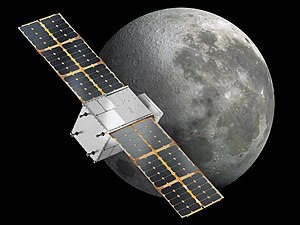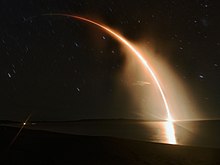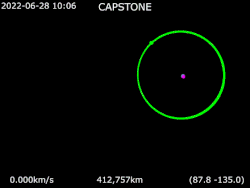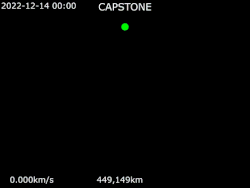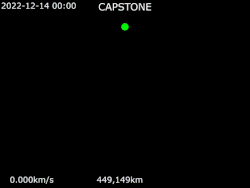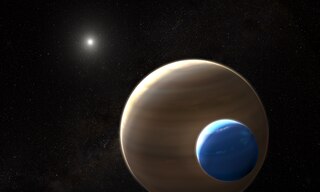
A subsatellite, also known as a submoon, is a "moon of a moon" or a hypothetical natural satellite that orbits the moon of a planet.
A distant retrograde orbit (DRO), as most commonly conceived, is a spacecraft orbit around a moon that is highly stable because of its interactions with two Lagrange points (L1 and L2) of the planet–moon system.

Lunar Flashlight was a low-cost CubeSat lunar orbiter mission to explore, locate, and estimate size and composition of water ice deposits on the Moon for future exploitation by robots or humans.

Lunar IceCube is a NASA nanosatellite orbiter mission that was intended to prospect, locate, and estimate amount and composition of water ice deposits on the Moon for future exploitation. It was launched as a secondary payload mission on Artemis 1, the first flight of the Space Launch System (SLS), on 16 November 2022. As of February 2023 it's unknown whether NASA team has contact with satellite or not.

LunIR is a nanosatellite spacecraft launched to the Moon collecting surface spectroscopy and thermography. It was launched as a secondary payload on the Artemis 1 mission on 16 November 2022.

Lunar Polar Hydrogen Mapper, or LunaH-Map, was one of the 10 CubeSats launched with Artemis 1 on 16 November 2022. Along with Lunar IceCube and LunIR, LunaH-Map will help investigate the possible presence of water-ice on the Moon. Arizona State University began development of LunaH-Map after being awarded a contract by NASA in early 2015. The development team consists of about 20 professionals and students led by Craig Hardgrove, the principal investigator. The mission is a part of NASA's SIMPLEx program.

Artemis 3 is planned to be the first crewed Moon landing mission of the Artemis program and the first crewed flight of the Starship HLS lander. Artemis 3 is planned to be the second crewed Artemis mission and the first American crewed lunar landing since Apollo 17 in December 1972. In December 2023, the Government Accountability Office reported that the mission is not likely to occur before 2027; as of January 2024, NASA officially expects Artemis 3 to launch no earlier than September 2026.
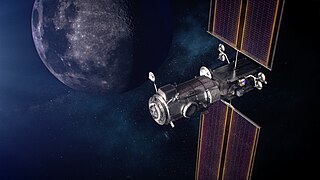
The Lunar Gateway, or simply Gateway, is a space station which Artemis program participants plan to assemble in an orbit near the Moon. The Gateway is intended to serve as a communication hub, science laboratory, and habitation module for astronauts. It is a multinational collaborative project: participants include NASA, the European Space Agency (ESA), the Japan Aerospace Exploration Agency (JAXA), the Canadian Space Agency (CSA) and the Mohammed Bin Rashid Space Centre (MBRSC). The Gateway is planned to be the first space station beyond low Earth orbit.

ArgoMoon is a CubeSat that was launched into a heliocentric orbit on Artemis 1, the maiden flight of the Space Launch System, on 16 November 2022 at 06:47:44 UTC. The objective of the ArgoMoon spacecraft is to take detailed images of the Interim Cryogenic Propulsion Stage following Orion separation, an operation that will demonstrate the ability of a cubesat to conduct precise proximity maneuvers in deep space. ASI has not confirmed nor denied whether this took place, but several images of the Earth and the Moon were taken.

Blue Moon is a family of lunar landers and their associated infrastructure, intended to carry humans and cargo to the Moon, currently under development by a consortium led by Blue Origin and including Lockheed Martin, Draper, Boeing, Astrobotic, and Honeybee Robotics. Two versions of Blue Moon are under development: a robotic lander planned to land on the Moon in 2024, and a larger human lander planned to land a crew of four astronauts on the lunar surface for the NASA Artemis V mission in 2029.
Cislunar Explorers is a pair of spacecraft that will show the viability of water electrolysis propulsion and interplanetary optical navigation to orbit the Moon. Both spacecraft will launch mated together as two L-shaped 3U CubeSats, which fit together as a 6U CubeSat of about 10 cm × 20 cm × 30 cm.
Team Miles was a 6U CubeSat that was to demonstrate navigation in deep space using innovative plasma thrusters. It was also to test a software-defined radio operating in the S-band for communications from about 4 million kilometers from Earth. Team Miles was one of ten CubeSats launched with the Artemis 1 mission into a heliocentric orbit in cislunar space on the maiden flight of the Space Launch System (SLS), that took place on 16 November 2022. Team Miles was deployed but contact was not established with the spacecraft.
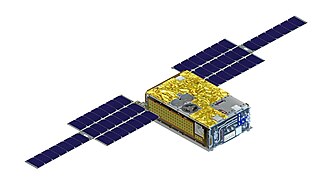
EQUULEUS is a nanosatellite of the 6U CubeSat format that will measure the distribution of plasma that surrounds the Earth (plasmasphere) to help scientists understand the radiation environment in that region. It will also demonstrate low-thrust trajectory control techniques, such as multiple lunar flybys, within the Earth-Moon region using water steam as propellant. The spacecraft was designed and developed jointly by the Japan Aerospace Exploration Agency (JAXA) and the University of Tokyo.

OMOTENASHI was a small spacecraft and semi-hard lander of the 6U CubeSat format intended to demonstrate low-cost technology to land and explore the lunar surface. The CubeSat was to take measurements of the radiation environment near the Moon as well as on the lunar surface. Omotenashi is a Japanese word for "welcome" or "Hospitality".

In orbital mechanics a near-rectilinear halo orbit (NRHO) is a halo orbit that passes close to the smaller of two bodies and has nearly stable behavior. The CAPSTONE mission, launched in 2022, is the first spacecraft to use such orbit in cislunar space, and this Moon-centric orbit is planned as a staging area for future lunar missions. In contrast with low lunar orbit which NASA characterizes as being deep in the lunar gravity well, NRHO is described as being "balanced on the edge" of the gravity well.

The Artemis program is a Moon exploration program that is led by the United States' NASA and was formally established in 2017 via Space Policy Directive 1. The Artemis program is intended to reestablish a human presence on the Moon for the first time since Apollo 17 in 1972. The program's stated long-term goal is to establish a permanent base on the Moon to facilitate human missions to Mars.

Artemis 4 is a planned mission of the NASA-led Artemis program. The mission will include the fourth use of a Space Launch System (SLS) launch vehicle, will send an Orion spacecraft with four astronauts to the Lunar Gateway space station, install a new module on the Gateway, and conduct the second lunar landing of the Artemis program.

Artemis 5 is the fifth planned mission of NASA's Artemis program and the first crewed flight of the Blue Moon lander. The mission will launch four astronauts on a Space Launch System rocket and an Orion to the Lunar Gateway and will be the third lunar landing of the Artemis program. In addition, Artemis V will also deliver two new elements to the Gateway Space Station.

Small Innovative Missions for Planetary Exploration (SIMPLEx) is a planetary exploration program operated by NASA. The program funds small, low-cost spacecraft for stand-alone planetary exploration missions. These spacecraft are intended to launch as secondary payloads on other missions and are riskier than Discovery or New Frontiers missions.
